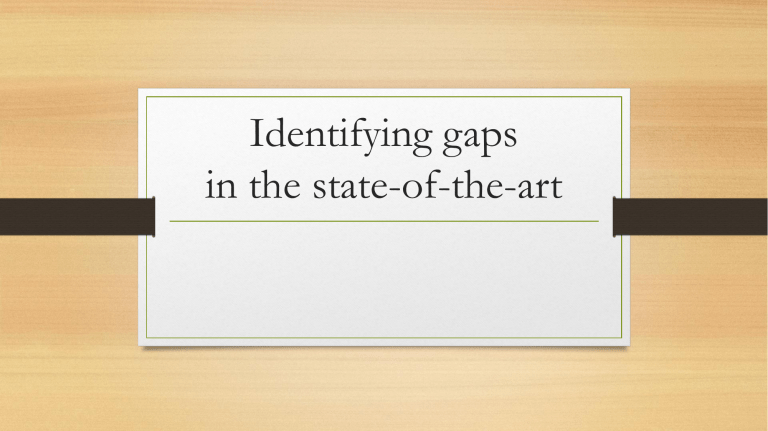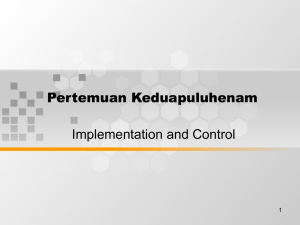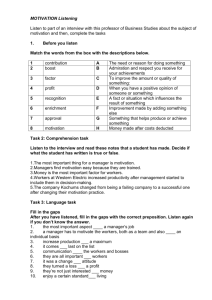Identifying Research Gaps in Qualitative Literature Reviews
advertisement

Identifying gaps in the state-of-the-art Introduction • Research gaps are defined as gaps in ‘sets of information’ • Identifying research gaps is a fundamental goal of literature reviewing • No methodological guidelines for how to identify research gaps in qualitative literature reviews ensuring rigor and replicability • A framework for identifying research gaps in qualitative literature reviews was proposed in 2015 by Christoph Müller-Bloch and Johann Kranz in “A Framework for Rigorously Identifying Research Gaps in Qualitative Literature Reviews” Broke model (2009) for a framework for literature reviewing Research gap/problem/agenda • Research Gap • represent an output of literature reviews, perceived as an input as for further research • it is possible to derive research gaps from other sources than literature syntheses • Research Problem • a statement that is resolved by means of research, not necessarily a research gap • when examined carefully a gap in sets of information results in a call for action or resolution • the term focuses it focuses on the function as input for research • Research Agenda • a set of questions for further research • it is not necessarily that all questions for further research are derived from research gaps • research gaps are a part of research agendas, but not necessarily exclusively Six forms of research problems (I) 1. Provocative exception: new research finding contradicts widely accepted conclusions 2. Contradictory evidence: occurs if results from studies allow for conclusions in their own right, but are contradictory when examined from a more abstract point of view 3. Knowledge void: knowledge may not exist in the actual field of research but in a related research domain; or results of a study differ from what was expected and motivate new research in this direction Six forms of research problems (II) 4. Action-knowledge conflict: arises when the actual behavior of professionals is different from their advocated behavior 5. Methodological conflict: occurs due to the influence of methodology on research results 6. Theoretical conflict: one phenomenon is being explained through various theoretical models Find examples from CS for the 6 RP types 1. 2. 3. 4. 5. 6. … … … … … … Chart method to identify research gaps in literature reviews • only one approach exists for identifying research gaps • chart each source according to predetermined categories • categories could feature, for example • types of variables examined, • level of analysis, • important theoretical issues Concept matrix Framework for identifying research gaps (Müller-Bloch & Kranz, 2015) Localization • commences when the literature is being synthesized • the procedure is often creative, implicit, and informal • the chart method can be used for research gap localization • perceive blank fields in the chart, which may indicate research gaps Localization strategy Characterization • means to classify research gaps owing to the reasons of their existence • Q: what kinds of sets of information are related to each other, and how are they related? • Characterization vs. localization: • the concept of characterization is capable of enhancing the process of localizing research gaps: • when trying to localize research gaps, researchers can constantly refer to the concept of characterization. • The characterization of research gaps might enable scholars to specify what kind of research is required to resolve the respective research gap. Eg. • A methodological conflict indicates that there is a need to vary research methods. • For contradictory evidence, new theories that enable the incorporation of all evidence and possibly explain the reasons for the existence of that particular contradictory evidence may be needed. Verification • means to ensure that the research gap does indeed exist • has the advantage of enabling researchers to substantially reduce the likelihood that the respective research gaps have been closed or do not exist, while not requiring an exhaustive literature review • not all literature reviews are exhaustive, meaning that not the entire relevant literature is included • there is a need to verify the research gaps derived from the synthesis since papers may have been overlooked that reveal that the research gaps were closed before • conduct a forward search, based on the articles from which the respective research gaps emerged or that are closely linked to the research gap • search relevant databases or scan prevailing textbooks for search terms that refer to the research gap Presentation • Sequential presentation describes the research gaps after the synthesis, such that the research gaps are presented separately from the synthesis • Parallel presentation features the research gaps during the discussion of the synthesis.



